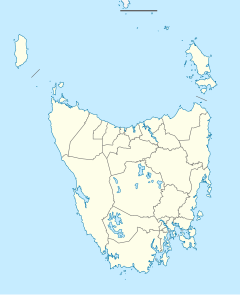Tasman National Park (Australia)
| Tasman National Park (Australia) | ||
|---|---|---|
| Cape Pillar | ||
|
|
||
| Location: | Tasmania , Australia | |
| Specialty: | Coastal landscape | |
| Next city: | Port Arthur | |
| Surface: | 97 km² | |
| Founding: | 1999 | |
| Address: |
Tasman National Park via Seven Mile Beach 293 Surf Road Seven Mile Beach TAS 7170 |
|
| Cape Hauy, in the background "The Lanterns" and the "Hippolyte Rocks" | ||
The Tasman National Park (ger .: Tasman National Park ) on the Australian island of Tasmania is located 56 km east of Hobart . The park extends along the east coast of the Forestier Peninsula and along the east and south coast of the Tasman Peninsula and covers approximately 100 km². It includes many islands, such as Fossil Island and Tasman Island . It was placed under protection in 1999 and serves to preserve the unique forest and coastal landscape, which is known for its beauty and diversity.
The park is named after the Dutch navigator Abel Tasman , who discovered Tasmania for the Europeans in 1642.
history
Even if the history of the Aborigines in the park has not yet been systematically investigated, it can be assumed that the area was permanently colonized by the Oyster Bay tribe, whose members visited both the coasts and the inland areas of the islands all year round.
On his historic journey, Abel Tasman landed on the Forestier Peninsula in 1642. However, the development of the coasts was very slow later. Around 1800 whaling stations were established, which generated a significant proportion of the exports of the young Australian colony. Since later this area was also to be colonized with convicts, some of the stations were closed again.
Wildlife
Numerous mammals can be found in the national park: Species such as the red-bellied filander , the red-necked wallaby and the wombat have become more common since the park was protected. While the Tasmanian devil and the spotted marten were more common in the past, it is now believed that they only live in a smaller population in parts of the park.
In the park are also z. B. the broad-footed pouch mouse species Antechinus swainsonii and Antechinus minimus , the Tasmanian long-nosed pouch and the small short-nosed pouch as well as seven bat species were detected.
On the coast you can u. a. observe the South African fur seal , leopard seal and elephant seal. The waters are also frequented by dolphins of various species, pilot whales , southern capers and humpback whales .
Due to the diverse habitats, numerous bird species also find their habitat here. These include a. the little penguin , the endangered species Thinornis rubricollis (a plover ) and the wedge-tailed eagle and the white-bellied sea eagle .
Flora
Three eyebright species are endemic only in coastal heather plant communities of this national park. These are the species Euphrasia amphisysepala, E. sp. 'fabula' and E. phragmostoma . Other species such as the cypress family Callitris rhomboidea , the heather family Richea dracophylla and the eucalyptus species Eucalyptus johnstonii reach their southernmost range here.
tourism
Hiking trails allow excursions along the coast. You can use them to get to cliffs in the south of the park, which are among the highest in Australia :
Nature Walks (short hike)
- Canoe Bay (two hours there and back)
Bushwalks (hiking)
- Cape Hauy Track (4 to 5 hours there and back) with the famous Totem Pole surf pillar
- Mount Fortescue Track (6 to 7 hours there and back)
- Tasman Trail (6 to 8 hours there and back)
- Cape Raoul (5 hours there and back)
Some of the spectacular views of the sea and rock formations are also directly accessible by car.
Web links
Individual evidence
- ↑ Information on the animal world on the homepage of Parks & Wildlife Service, engl.
- ↑ Information on the flora on the homepage of Parks & Wildlife Service, engl.


